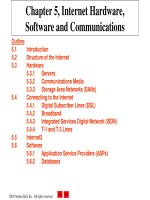Lecture Health economics - Chapter 5: Medical care production and costs
Bạn đang xem bản rút gọn của tài liệu. Xem và tải ngay bản đầy đủ của tài liệu tại đây (514.64 KB, 49 trang )
Medical Care Production and
Costs
Health Economics
Fall 2009
Professor Vivian Ho
Outline
Motivation
Productivity Measures
Cost Measures
Mergers are transforming the
industry
2000 – NE Georgia Health system proposed to
buy Lanier Park Hospital in Gainesville
estimated cost savings of $2 million annually.
2005 – United Health Group (insurance)
proposed to merge with PacifiCare Health
Systems (also an insurer)
• 26 million customers.
•
would lead to $100 million cut in operating costs
in first year alone.
Mergers are transforming the
industry (cont.)
But will mergers help to contain costs and/or
improve productivity in the industry?
• Depends upon production and costs in the
health care sector.
Assessing the Productivity of
Medical Firms
Economists often describe production of output
as a function of labor and capital :
q = f(n,k)
•
In the case of health care :
q =
n =
k =
hospital services
nurses
medical equipment, hospital building
Assessing the Productivity of
Medical Firms (cont.)
Short run : k is fixed, while n is variable
a) At low level of n, k is abundant. Each in nurses
when combined with capital greater in services.
- potential synergy effect because nurses can
work in teams.
b) Further in nurses
service, but a decreasing
rate - law of diminishing marginal productivity.
c) “Too many “ nurses can cause congestion, communication problems,
hospital services
Substitutability in Production of
Medical Care
There may be more than one way to produce
a given level of health care.
Licenced
practical nurses (LPNs) vs
Registered Nurses (RNs) in hospitals.
LPNs have less training.
Maybe not as productive, but not as costly.
Physician assistants vs physicians at
ambulatory clinics.
But physician assistants can’t prescribe meds in
most states.
Substitutability in Production of
Medical Care (cont.)
Potential
for substitutability
If price of 1 input
increases, can minimize impact on total costs by
substituting away.
Elasticity of substitution :
= [(I1/I2)/I1/I2] : [(MP2/MP1)/MP2/MP1]
% change in input ratio, divided by % change in
ratio of inputs’ MPs.
=0
=
8
no substitutability.
perfect substitutability.
Production Function for Hospital
Admissions
Jensen and Morrisey (1986)
Sample : 3,450 non-teaching hospitals in 1983.
q = hospital admissions
inputs : physicians, nurses, other staff, hospital beds.
q =
0
+
physicians +
1
nurses + …. +
2
Coefficients in regression are MPs.
Results
Annual Marginal Products for Admissions
Input
Physicians
Nurses
Other Staff
Beds
•
•
MP (at the means)
6.05
20.30
6.97
3.04
Each additional physician generated 6.05 more
admits per year.
Nurses by far the most productive
Results (cont.)
Elasticity of Substitution between Inputs
Input pair
Physicians with nurses
Physicians with beds
Nurses with beds
•
0.547
0.175
0.124
Each inputs is a substitute for other in production
process.
• If wages of nurses rise, can substitute away by
having more
hospital
beds.= 0
Except
for when
Medical Care Cost
Accounting Costs
Explicit costs of doing business.
• e.g. staff payroll, utility bills, medical supply costs.
Necessary for :
•
•
•
Comparing performance evaluation across
providers/depts.
Taxes
Government reimbursement/rate setting
Medical Care Cost (cost.)
Economic Costs
= Accounting Costs
i.e. opportunity costs.
• e.g. opportunity cost of a facility being used as an
outpatient clinic = rent it could earn otherwise.
Necessary for :
•
•
optimal business planning.
allows one to consider highest returns to assets
anywhere, not just vs. direct competitors, or w/in
health care industry.
Short-Run Total Cost
STC( q ) = w n + r k*
w = wage rate for nurses r = rental price of capital
short run k fixed w n = variable cost
r k = fixed cost .
cost
STC
STC
w n
r k
q0
hospital service
Short-Run Total Cost (cont.)
STC( q ) = w n + r k*
• In the short run, k is fixed.
rk* is the same, regardless of the amount of
hospital services (q) produced.
As q rises, increases in STC are only due to
•increases
in the number of nurses needed (n).
Marginal and Average Costs
SMC =
=
ST
C
q
(wn + rk*)/ q
= w( n/ q) = w(1/MPn)
= w/MPn
The short run marginal cost of nurses depends
on their marginal productivity.
Marginal and Average Costs (cont).
SAVC =
STVC
q
= (wn)/q
= w(1/APn)
= w/APn
The short run average variable cost of nurses
depends on their average productivity.
Graphing Marginal and Average Costs
SMC
Costs
SMC0
SATC
SAVC
SATC0
SAVC0
0
q0
q
Graphing Marginal and Average Costs
SATC and SAVC are u-shaped curves.
Increasing
returns to scale followed by
decreasing returns to scale.
SMC passes through the minimum of
both SATC and SAVC.
If
marginal cost is greater than average
cost, then the cost of one additional unit of
output must cause the average to rise.
Average and Marginal Costs (cont.)
IRTS followed by DRTS in production leads to U
shaped AC curve.
Hospital doesn’t necessarily produce at q* (min.
cost).
Depends on hospital’s objectives.
Even so, will attempt to stay on the cost curve
(not above it).
Average and Marginal Costs (cont.)
Why do all of these cost curves matter?
Many hospitals operate at a loss
(profits<0) in some years.
If
a hospital seeks to maximize profits, and
it knows it’s going to lose money in a given
year, why should it treat any patients?
In the SR, a hospital will still stay open if
treating patients will cover its fixed costs
and part of its variable costs.
MC
Price per
Patient
ATC
P=MR
AVC
0
q*
Patients
The hospital will receive a price P from
insurers for each patient treated.
To
max profits, choose q* where MR=MC.
Price per
Patient
MC
C
P
0
B
A
q*
ATC
P=MC
AVC
Patients
At output q*, the hospital’s revenues are
PAq*0.
The hospital’s total costs are CBq*0.
The hospital earns negative profits CBAP.
MC
Price per
Patient
C
P
E
0
B
A
ATC
AVC
D
q*
Patients
The hospital’s FC are (ATC-AVC)q*, or CBDE.
If the hospital shuts down, it must still pay for FC.
Since CBDE>CBAP, the hospital will lose less if it
remains open.
In the SR, FC are critical for
determining whether a hospital should
stay open for business.
So, in general, how large are FC?
Study of Cook County Hospital in
Chicago (Roberts, JAMA 1999)
Urban
public teaching hospital, 1993









